Project Management Analysis of Blue Circle Cement Case Study
VerifiedAdded on 2021/10/08
|15
|3839
|124
Project
AI Summary
This project management analysis focuses on the case study of Blue Circle Cement, a major cement producer in the United Kingdom, and the organizational changes it underwent, particularly at its Cauldon Works. The assignment delves into the company's challenges, including issues related to employee structure, overtime, productivity, and restrictive working practices. It highlights the implementation of project management principles, including project planning and total quality management (TQM), as solutions to these problems. The analysis explores the importance of project plans in establishing stable income plans, improving productivity, and fostering a more collaborative work environment. It also examines the development of a total quality approach, emphasizing principles like executive management, training, decision-making, continuous improvement, and employee involvement. The study demonstrates how Blue Circle Cement successfully addressed its issues through these strategies, resulting in increased production and improved business operations. The analysis underscores the significance of leadership in driving these changes and the adoption of a common vision to build a highly skilled and flexible workforce. The project management approach and TQM were crucial in eliminating wasteful practices and improving overall quality, leading to the company's success.
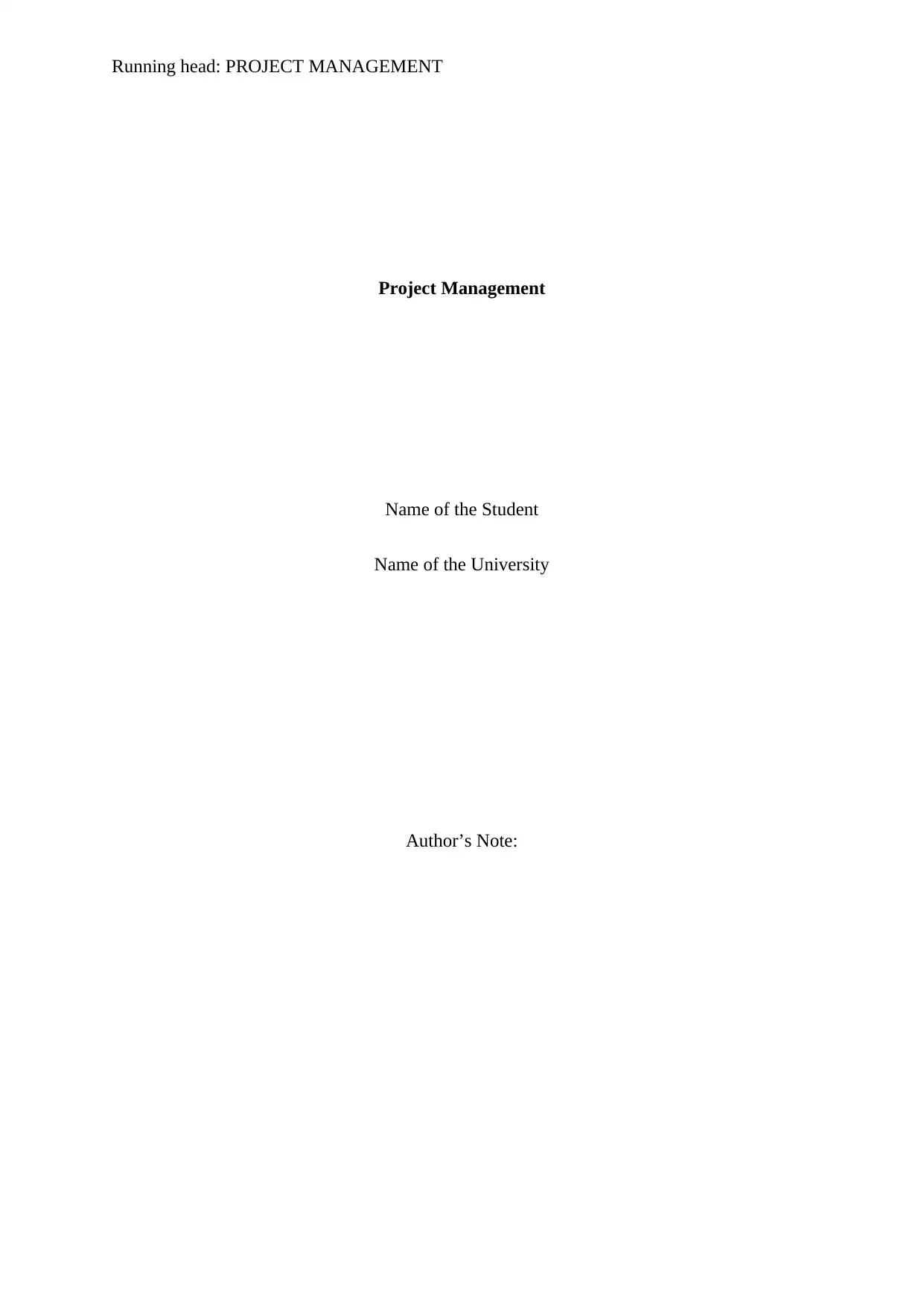
Running head: PROJECT MANAGEMENT
Project Management
Name of the Student
Name of the University
Author’s Note:
Project Management
Name of the Student
Name of the University
Author’s Note:
Paraphrase This Document
Need a fresh take? Get an instant paraphrase of this document with our AI Paraphraser
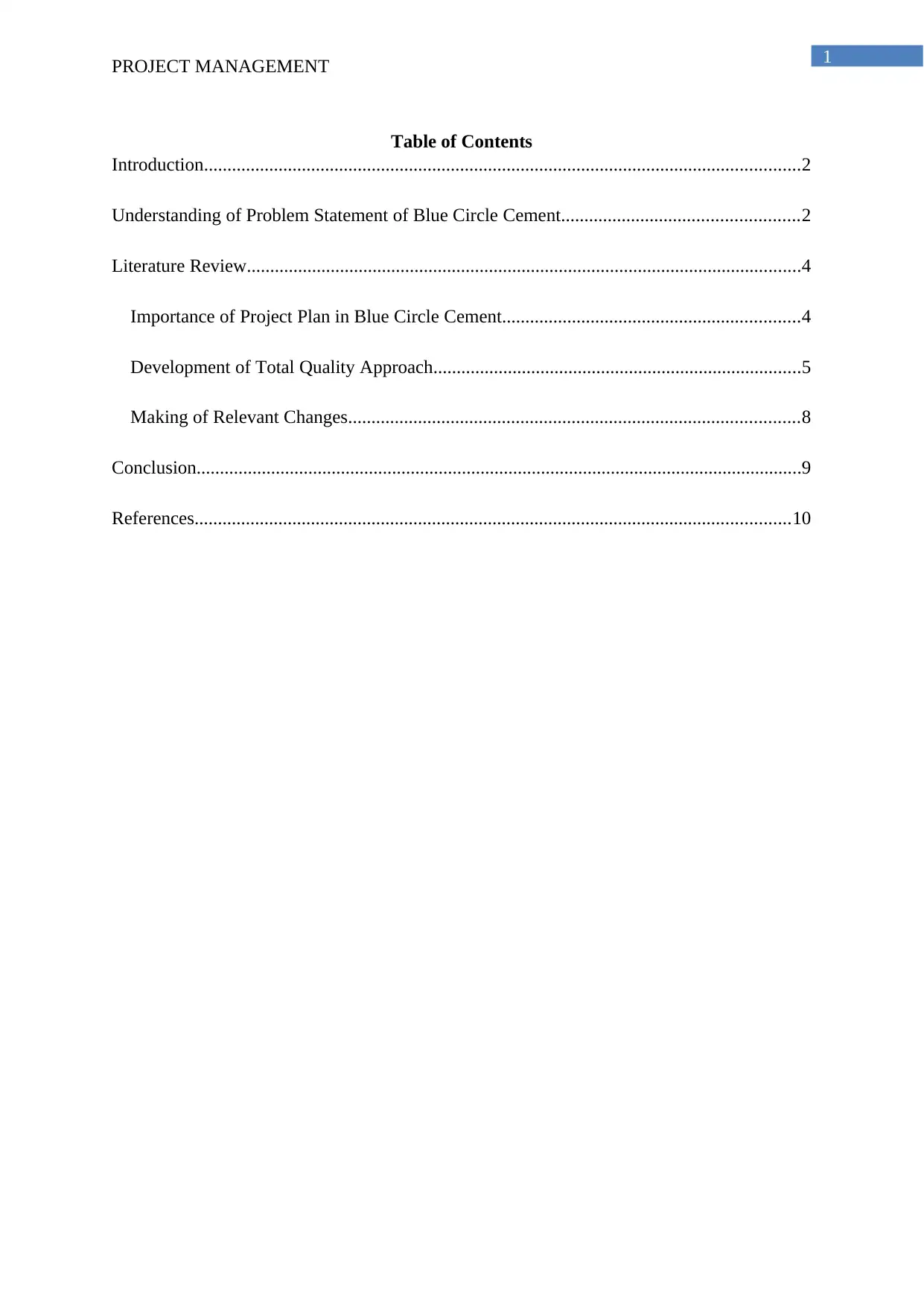
1
PROJECT MANAGEMENT
Table of Contents
Introduction................................................................................................................................2
Understanding of Problem Statement of Blue Circle Cement...................................................2
Literature Review.......................................................................................................................4
Importance of Project Plan in Blue Circle Cement................................................................4
Development of Total Quality Approach...............................................................................5
Making of Relevant Changes.................................................................................................8
Conclusion..................................................................................................................................9
References................................................................................................................................10
PROJECT MANAGEMENT
Table of Contents
Introduction................................................................................................................................2
Understanding of Problem Statement of Blue Circle Cement...................................................2
Literature Review.......................................................................................................................4
Importance of Project Plan in Blue Circle Cement................................................................4
Development of Total Quality Approach...............................................................................5
Making of Relevant Changes.................................................................................................8
Conclusion..................................................................................................................................9
References................................................................................................................................10
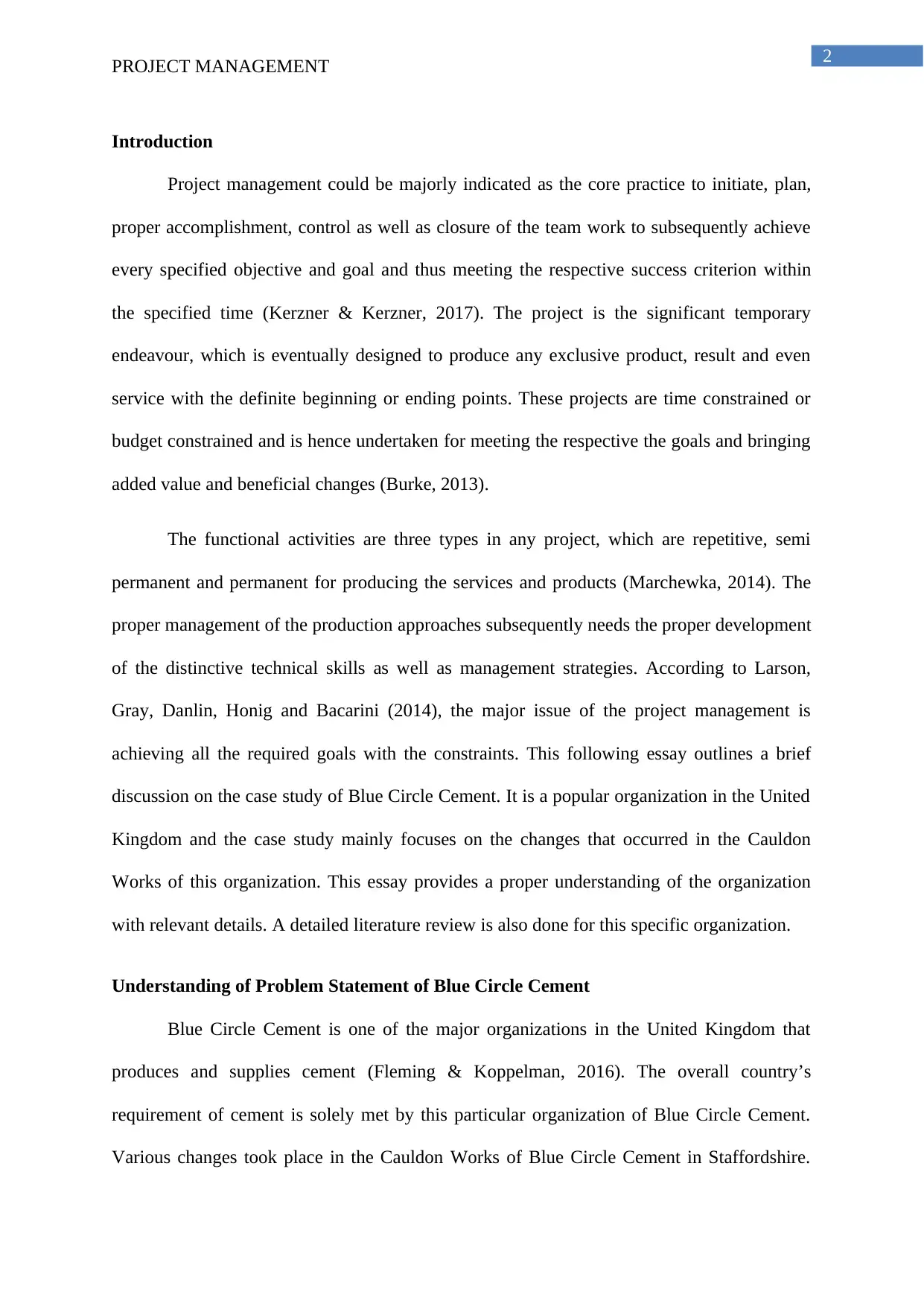
2
PROJECT MANAGEMENT
Introduction
Project management could be majorly indicated as the core practice to initiate, plan,
proper accomplishment, control as well as closure of the team work to subsequently achieve
every specified objective and goal and thus meeting the respective success criterion within
the specified time (Kerzner & Kerzner, 2017). The project is the significant temporary
endeavour, which is eventually designed to produce any exclusive product, result and even
service with the definite beginning or ending points. These projects are time constrained or
budget constrained and is hence undertaken for meeting the respective the goals and bringing
added value and beneficial changes (Burke, 2013).
The functional activities are three types in any project, which are repetitive, semi
permanent and permanent for producing the services and products (Marchewka, 2014). The
proper management of the production approaches subsequently needs the proper development
of the distinctive technical skills as well as management strategies. According to Larson,
Gray, Danlin, Honig and Bacarini (2014), the major issue of the project management is
achieving all the required goals with the constraints. This following essay outlines a brief
discussion on the case study of Blue Circle Cement. It is a popular organization in the United
Kingdom and the case study mainly focuses on the changes that occurred in the Cauldon
Works of this organization. This essay provides a proper understanding of the organization
with relevant details. A detailed literature review is also done for this specific organization.
Understanding of Problem Statement of Blue Circle Cement
Blue Circle Cement is one of the major organizations in the United Kingdom that
produces and supplies cement (Fleming & Koppelman, 2016). The overall country’s
requirement of cement is solely met by this particular organization of Blue Circle Cement.
Various changes took place in the Cauldon Works of Blue Circle Cement in Staffordshire.
PROJECT MANAGEMENT
Introduction
Project management could be majorly indicated as the core practice to initiate, plan,
proper accomplishment, control as well as closure of the team work to subsequently achieve
every specified objective and goal and thus meeting the respective success criterion within
the specified time (Kerzner & Kerzner, 2017). The project is the significant temporary
endeavour, which is eventually designed to produce any exclusive product, result and even
service with the definite beginning or ending points. These projects are time constrained or
budget constrained and is hence undertaken for meeting the respective the goals and bringing
added value and beneficial changes (Burke, 2013).
The functional activities are three types in any project, which are repetitive, semi
permanent and permanent for producing the services and products (Marchewka, 2014). The
proper management of the production approaches subsequently needs the proper development
of the distinctive technical skills as well as management strategies. According to Larson,
Gray, Danlin, Honig and Bacarini (2014), the major issue of the project management is
achieving all the required goals with the constraints. This following essay outlines a brief
discussion on the case study of Blue Circle Cement. It is a popular organization in the United
Kingdom and the case study mainly focuses on the changes that occurred in the Cauldon
Works of this organization. This essay provides a proper understanding of the organization
with relevant details. A detailed literature review is also done for this specific organization.
Understanding of Problem Statement of Blue Circle Cement
Blue Circle Cement is one of the major organizations in the United Kingdom that
produces and supplies cement (Fleming & Koppelman, 2016). The overall country’s
requirement of cement is solely met by this particular organization of Blue Circle Cement.
Various changes took place in the Cauldon Works of Blue Circle Cement in Staffordshire.
⊘ This is a preview!⊘
Do you want full access?
Subscribe today to unlock all pages.

Trusted by 1+ million students worldwide
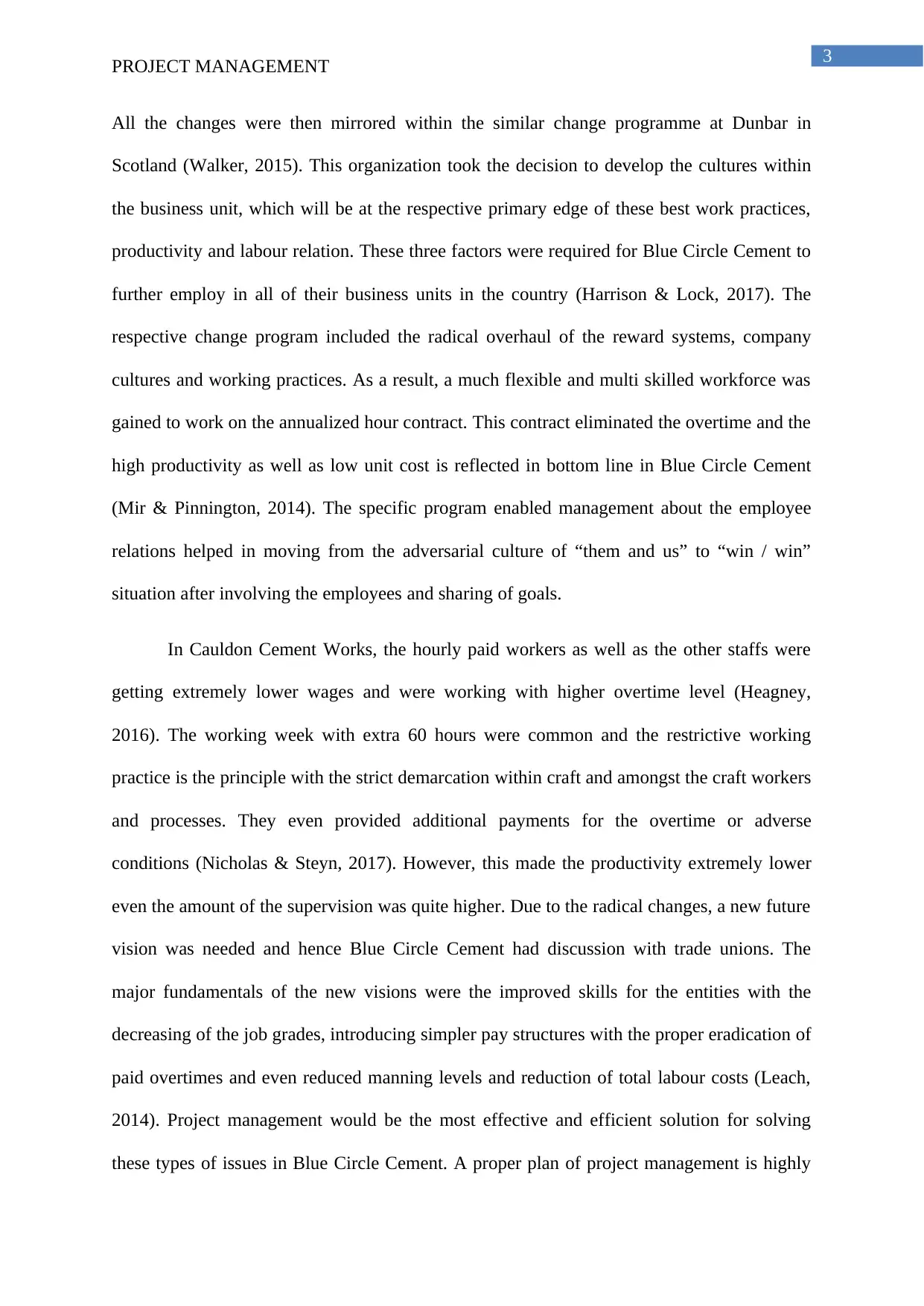
3
PROJECT MANAGEMENT
All the changes were then mirrored within the similar change programme at Dunbar in
Scotland (Walker, 2015). This organization took the decision to develop the cultures within
the business unit, which will be at the respective primary edge of these best work practices,
productivity and labour relation. These three factors were required for Blue Circle Cement to
further employ in all of their business units in the country (Harrison & Lock, 2017). The
respective change program included the radical overhaul of the reward systems, company
cultures and working practices. As a result, a much flexible and multi skilled workforce was
gained to work on the annualized hour contract. This contract eliminated the overtime and the
high productivity as well as low unit cost is reflected in bottom line in Blue Circle Cement
(Mir & Pinnington, 2014). The specific program enabled management about the employee
relations helped in moving from the adversarial culture of “them and us” to “win / win”
situation after involving the employees and sharing of goals.
In Cauldon Cement Works, the hourly paid workers as well as the other staffs were
getting extremely lower wages and were working with higher overtime level (Heagney,
2016). The working week with extra 60 hours were common and the restrictive working
practice is the principle with the strict demarcation within craft and amongst the craft workers
and processes. They even provided additional payments for the overtime or adverse
conditions (Nicholas & Steyn, 2017). However, this made the productivity extremely lower
even the amount of the supervision was quite higher. Due to the radical changes, a new future
vision was needed and hence Blue Circle Cement had discussion with trade unions. The
major fundamentals of the new visions were the improved skills for the entities with the
decreasing of the job grades, introducing simpler pay structures with the proper eradication of
paid overtimes and even reduced manning levels and reduction of total labour costs (Leach,
2014). Project management would be the most effective and efficient solution for solving
these types of issues in Blue Circle Cement. A proper plan of project management is highly
PROJECT MANAGEMENT
All the changes were then mirrored within the similar change programme at Dunbar in
Scotland (Walker, 2015). This organization took the decision to develop the cultures within
the business unit, which will be at the respective primary edge of these best work practices,
productivity and labour relation. These three factors were required for Blue Circle Cement to
further employ in all of their business units in the country (Harrison & Lock, 2017). The
respective change program included the radical overhaul of the reward systems, company
cultures and working practices. As a result, a much flexible and multi skilled workforce was
gained to work on the annualized hour contract. This contract eliminated the overtime and the
high productivity as well as low unit cost is reflected in bottom line in Blue Circle Cement
(Mir & Pinnington, 2014). The specific program enabled management about the employee
relations helped in moving from the adversarial culture of “them and us” to “win / win”
situation after involving the employees and sharing of goals.
In Cauldon Cement Works, the hourly paid workers as well as the other staffs were
getting extremely lower wages and were working with higher overtime level (Heagney,
2016). The working week with extra 60 hours were common and the restrictive working
practice is the principle with the strict demarcation within craft and amongst the craft workers
and processes. They even provided additional payments for the overtime or adverse
conditions (Nicholas & Steyn, 2017). However, this made the productivity extremely lower
even the amount of the supervision was quite higher. Due to the radical changes, a new future
vision was needed and hence Blue Circle Cement had discussion with trade unions. The
major fundamentals of the new visions were the improved skills for the entities with the
decreasing of the job grades, introducing simpler pay structures with the proper eradication of
paid overtimes and even reduced manning levels and reduction of total labour costs (Leach,
2014). Project management would be the most effective and efficient solution for solving
these types of issues in Blue Circle Cement. A proper plan of project management is highly
Paraphrase This Document
Need a fresh take? Get an instant paraphrase of this document with our AI Paraphraser
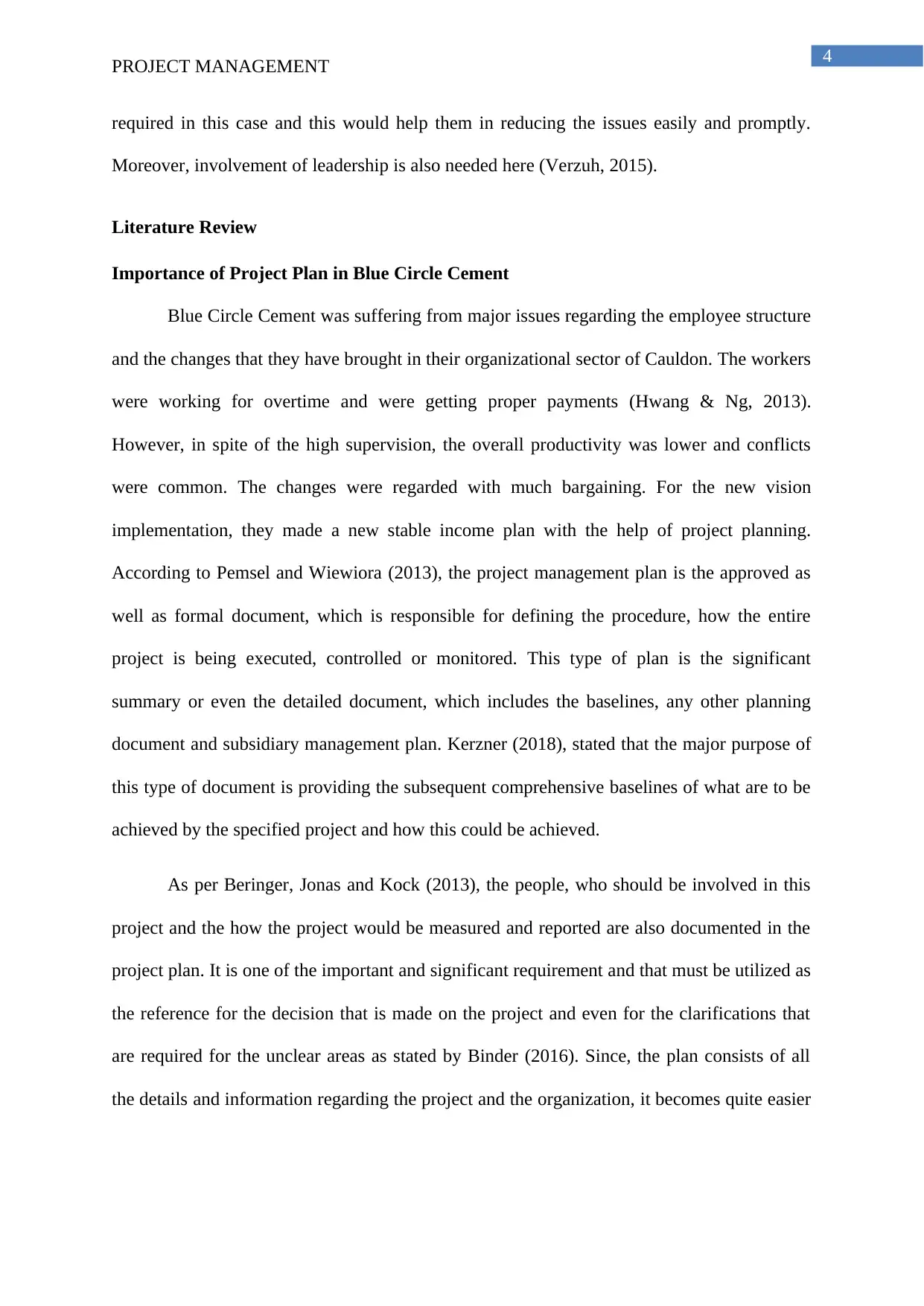
4
PROJECT MANAGEMENT
required in this case and this would help them in reducing the issues easily and promptly.
Moreover, involvement of leadership is also needed here (Verzuh, 2015).
Literature Review
Importance of Project Plan in Blue Circle Cement
Blue Circle Cement was suffering from major issues regarding the employee structure
and the changes that they have brought in their organizational sector of Cauldon. The workers
were working for overtime and were getting proper payments (Hwang & Ng, 2013).
However, in spite of the high supervision, the overall productivity was lower and conflicts
were common. The changes were regarded with much bargaining. For the new vision
implementation, they made a new stable income plan with the help of project planning.
According to Pemsel and Wiewiora (2013), the project management plan is the approved as
well as formal document, which is responsible for defining the procedure, how the entire
project is being executed, controlled or monitored. This type of plan is the significant
summary or even the detailed document, which includes the baselines, any other planning
document and subsidiary management plan. Kerzner (2018), stated that the major purpose of
this type of document is providing the subsequent comprehensive baselines of what are to be
achieved by the specified project and how this could be achieved.
As per Beringer, Jonas and Kock (2013), the people, who should be involved in this
project and the how the project would be measured and reported are also documented in the
project plan. It is one of the important and significant requirement and that must be utilized as
the reference for the decision that is made on the project and even for the clarifications that
are required for the unclear areas as stated by Binder (2016). Since, the plan consists of all
the details and information regarding the project and the organization, it becomes quite easier
PROJECT MANAGEMENT
required in this case and this would help them in reducing the issues easily and promptly.
Moreover, involvement of leadership is also needed here (Verzuh, 2015).
Literature Review
Importance of Project Plan in Blue Circle Cement
Blue Circle Cement was suffering from major issues regarding the employee structure
and the changes that they have brought in their organizational sector of Cauldon. The workers
were working for overtime and were getting proper payments (Hwang & Ng, 2013).
However, in spite of the high supervision, the overall productivity was lower and conflicts
were common. The changes were regarded with much bargaining. For the new vision
implementation, they made a new stable income plan with the help of project planning.
According to Pemsel and Wiewiora (2013), the project management plan is the approved as
well as formal document, which is responsible for defining the procedure, how the entire
project is being executed, controlled or monitored. This type of plan is the significant
summary or even the detailed document, which includes the baselines, any other planning
document and subsidiary management plan. Kerzner (2018), stated that the major purpose of
this type of document is providing the subsequent comprehensive baselines of what are to be
achieved by the specified project and how this could be achieved.
As per Beringer, Jonas and Kock (2013), the people, who should be involved in this
project and the how the project would be measured and reported are also documented in the
project plan. It is one of the important and significant requirement and that must be utilized as
the reference for the decision that is made on the project and even for the clarifications that
are required for the unclear areas as stated by Binder (2016). Since, the plan consists of all
the details and information regarding the project and the organization, it becomes quite easier
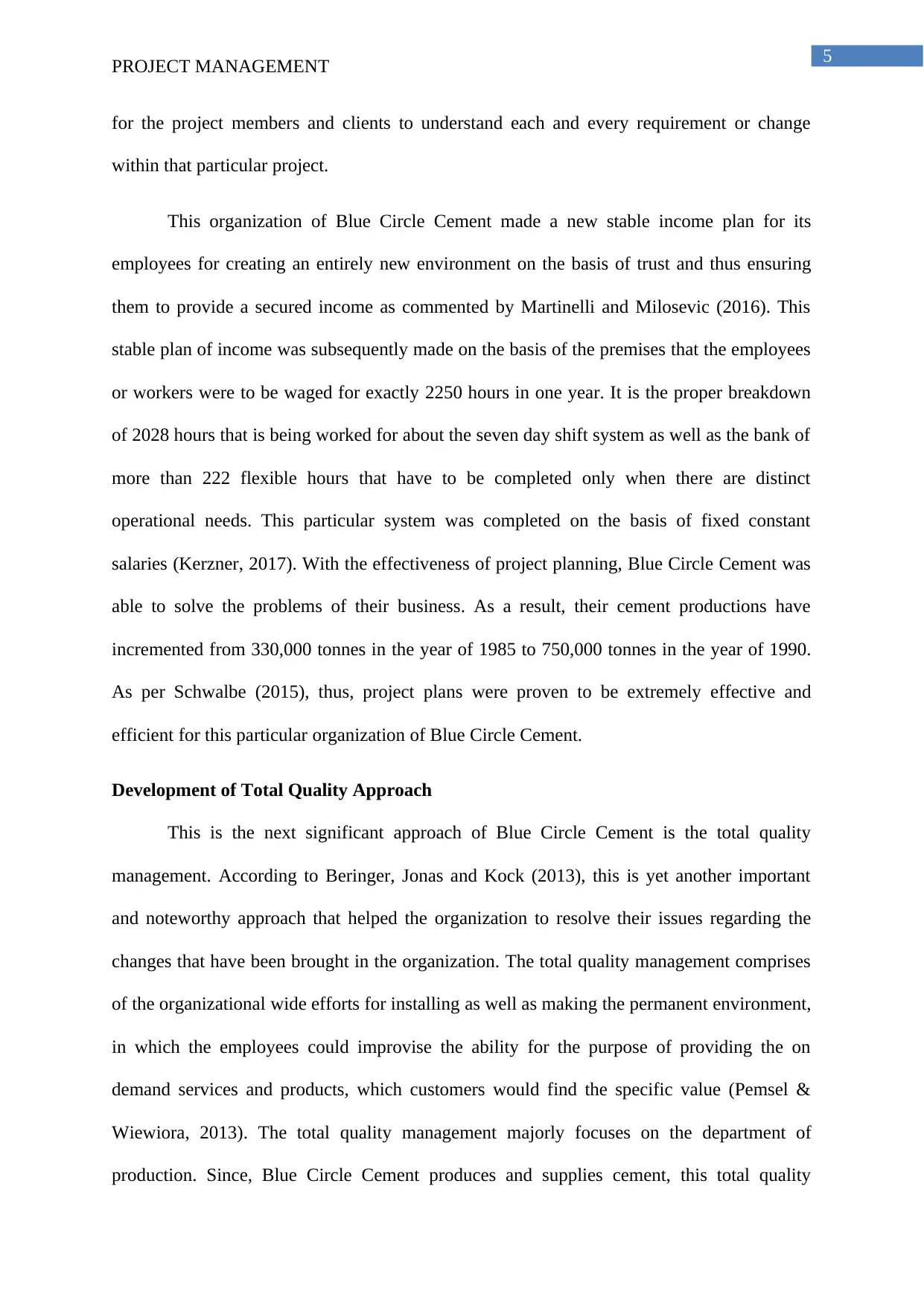
5
PROJECT MANAGEMENT
for the project members and clients to understand each and every requirement or change
within that particular project.
This organization of Blue Circle Cement made a new stable income plan for its
employees for creating an entirely new environment on the basis of trust and thus ensuring
them to provide a secured income as commented by Martinelli and Milosevic (2016). This
stable plan of income was subsequently made on the basis of the premises that the employees
or workers were to be waged for exactly 2250 hours in one year. It is the proper breakdown
of 2028 hours that is being worked for about the seven day shift system as well as the bank of
more than 222 flexible hours that have to be completed only when there are distinct
operational needs. This particular system was completed on the basis of fixed constant
salaries (Kerzner, 2017). With the effectiveness of project planning, Blue Circle Cement was
able to solve the problems of their business. As a result, their cement productions have
incremented from 330,000 tonnes in the year of 1985 to 750,000 tonnes in the year of 1990.
As per Schwalbe (2015), thus, project plans were proven to be extremely effective and
efficient for this particular organization of Blue Circle Cement.
Development of Total Quality Approach
This is the next significant approach of Blue Circle Cement is the total quality
management. According to Beringer, Jonas and Kock (2013), this is yet another important
and noteworthy approach that helped the organization to resolve their issues regarding the
changes that have been brought in the organization. The total quality management comprises
of the organizational wide efforts for installing as well as making the permanent environment,
in which the employees could improvise the ability for the purpose of providing the on
demand services and products, which customers would find the specific value (Pemsel &
Wiewiora, 2013). The total quality management majorly focuses on the department of
production. Since, Blue Circle Cement produces and supplies cement, this total quality
PROJECT MANAGEMENT
for the project members and clients to understand each and every requirement or change
within that particular project.
This organization of Blue Circle Cement made a new stable income plan for its
employees for creating an entirely new environment on the basis of trust and thus ensuring
them to provide a secured income as commented by Martinelli and Milosevic (2016). This
stable plan of income was subsequently made on the basis of the premises that the employees
or workers were to be waged for exactly 2250 hours in one year. It is the proper breakdown
of 2028 hours that is being worked for about the seven day shift system as well as the bank of
more than 222 flexible hours that have to be completed only when there are distinct
operational needs. This particular system was completed on the basis of fixed constant
salaries (Kerzner, 2017). With the effectiveness of project planning, Blue Circle Cement was
able to solve the problems of their business. As a result, their cement productions have
incremented from 330,000 tonnes in the year of 1985 to 750,000 tonnes in the year of 1990.
As per Schwalbe (2015), thus, project plans were proven to be extremely effective and
efficient for this particular organization of Blue Circle Cement.
Development of Total Quality Approach
This is the next significant approach of Blue Circle Cement is the total quality
management. According to Beringer, Jonas and Kock (2013), this is yet another important
and noteworthy approach that helped the organization to resolve their issues regarding the
changes that have been brought in the organization. The total quality management comprises
of the organizational wide efforts for installing as well as making the permanent environment,
in which the employees could improvise the ability for the purpose of providing the on
demand services and products, which customers would find the specific value (Pemsel &
Wiewiora, 2013). The total quality management majorly focuses on the department of
production. Since, Blue Circle Cement produces and supplies cement, this total quality
⊘ This is a preview!⊘
Do you want full access?
Subscribe today to unlock all pages.

Trusted by 1+ million students worldwide
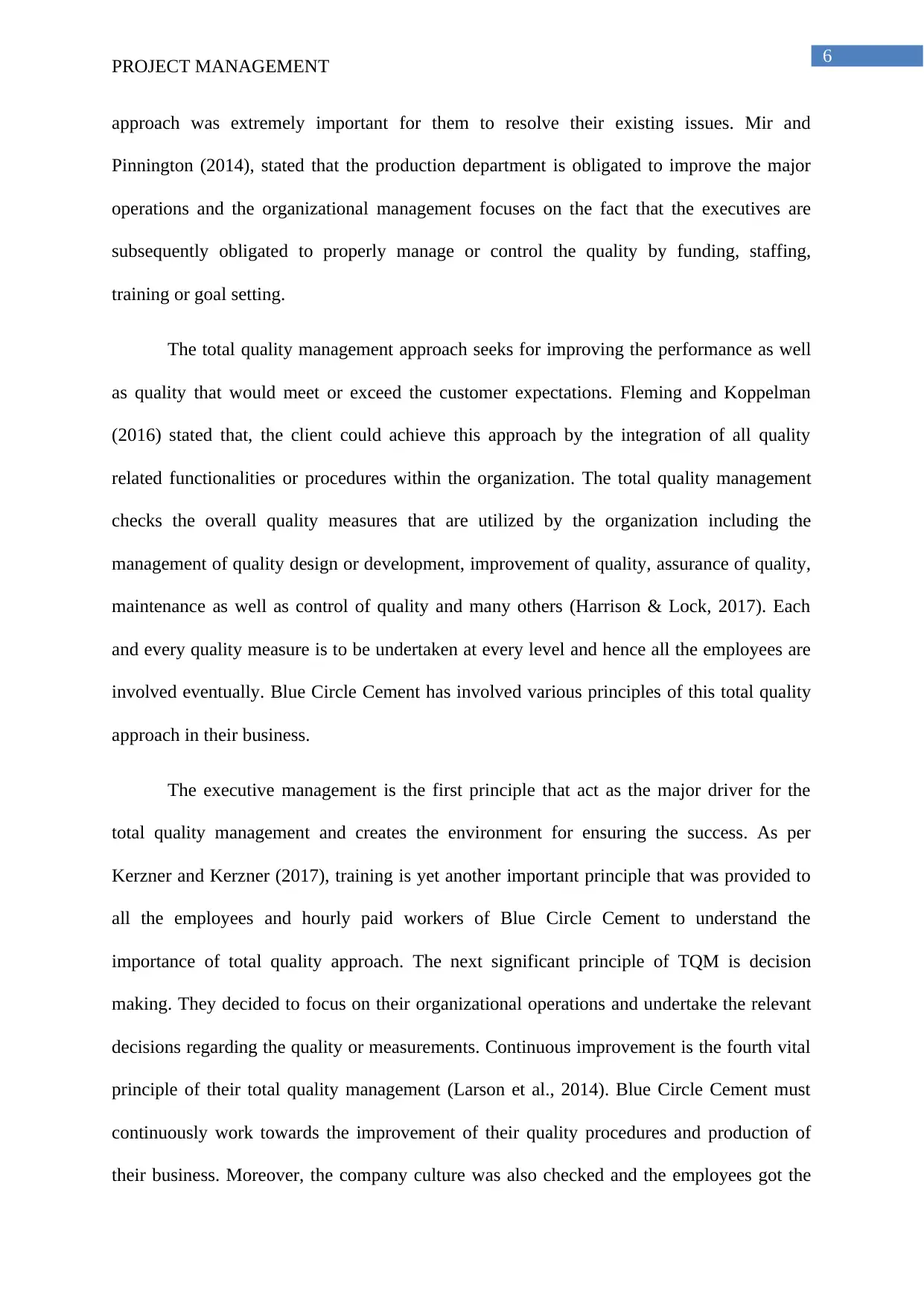
6
PROJECT MANAGEMENT
approach was extremely important for them to resolve their existing issues. Mir and
Pinnington (2014), stated that the production department is obligated to improve the major
operations and the organizational management focuses on the fact that the executives are
subsequently obligated to properly manage or control the quality by funding, staffing,
training or goal setting.
The total quality management approach seeks for improving the performance as well
as quality that would meet or exceed the customer expectations. Fleming and Koppelman
(2016) stated that, the client could achieve this approach by the integration of all quality
related functionalities or procedures within the organization. The total quality management
checks the overall quality measures that are utilized by the organization including the
management of quality design or development, improvement of quality, assurance of quality,
maintenance as well as control of quality and many others (Harrison & Lock, 2017). Each
and every quality measure is to be undertaken at every level and hence all the employees are
involved eventually. Blue Circle Cement has involved various principles of this total quality
approach in their business.
The executive management is the first principle that act as the major driver for the
total quality management and creates the environment for ensuring the success. As per
Kerzner and Kerzner (2017), training is yet another important principle that was provided to
all the employees and hourly paid workers of Blue Circle Cement to understand the
importance of total quality approach. The next significant principle of TQM is decision
making. They decided to focus on their organizational operations and undertake the relevant
decisions regarding the quality or measurements. Continuous improvement is the fourth vital
principle of their total quality management (Larson et al., 2014). Blue Circle Cement must
continuously work towards the improvement of their quality procedures and production of
their business. Moreover, the company culture was also checked and the employees got the
PROJECT MANAGEMENT
approach was extremely important for them to resolve their existing issues. Mir and
Pinnington (2014), stated that the production department is obligated to improve the major
operations and the organizational management focuses on the fact that the executives are
subsequently obligated to properly manage or control the quality by funding, staffing,
training or goal setting.
The total quality management approach seeks for improving the performance as well
as quality that would meet or exceed the customer expectations. Fleming and Koppelman
(2016) stated that, the client could achieve this approach by the integration of all quality
related functionalities or procedures within the organization. The total quality management
checks the overall quality measures that are utilized by the organization including the
management of quality design or development, improvement of quality, assurance of quality,
maintenance as well as control of quality and many others (Harrison & Lock, 2017). Each
and every quality measure is to be undertaken at every level and hence all the employees are
involved eventually. Blue Circle Cement has involved various principles of this total quality
approach in their business.
The executive management is the first principle that act as the major driver for the
total quality management and creates the environment for ensuring the success. As per
Kerzner and Kerzner (2017), training is yet another important principle that was provided to
all the employees and hourly paid workers of Blue Circle Cement to understand the
importance of total quality approach. The next significant principle of TQM is decision
making. They decided to focus on their organizational operations and undertake the relevant
decisions regarding the quality or measurements. Continuous improvement is the fourth vital
principle of their total quality management (Larson et al., 2014). Blue Circle Cement must
continuously work towards the improvement of their quality procedures and production of
their business. Moreover, the company culture was also checked and the employees got the
Paraphrase This Document
Need a fresh take? Get an instant paraphrase of this document with our AI Paraphraser
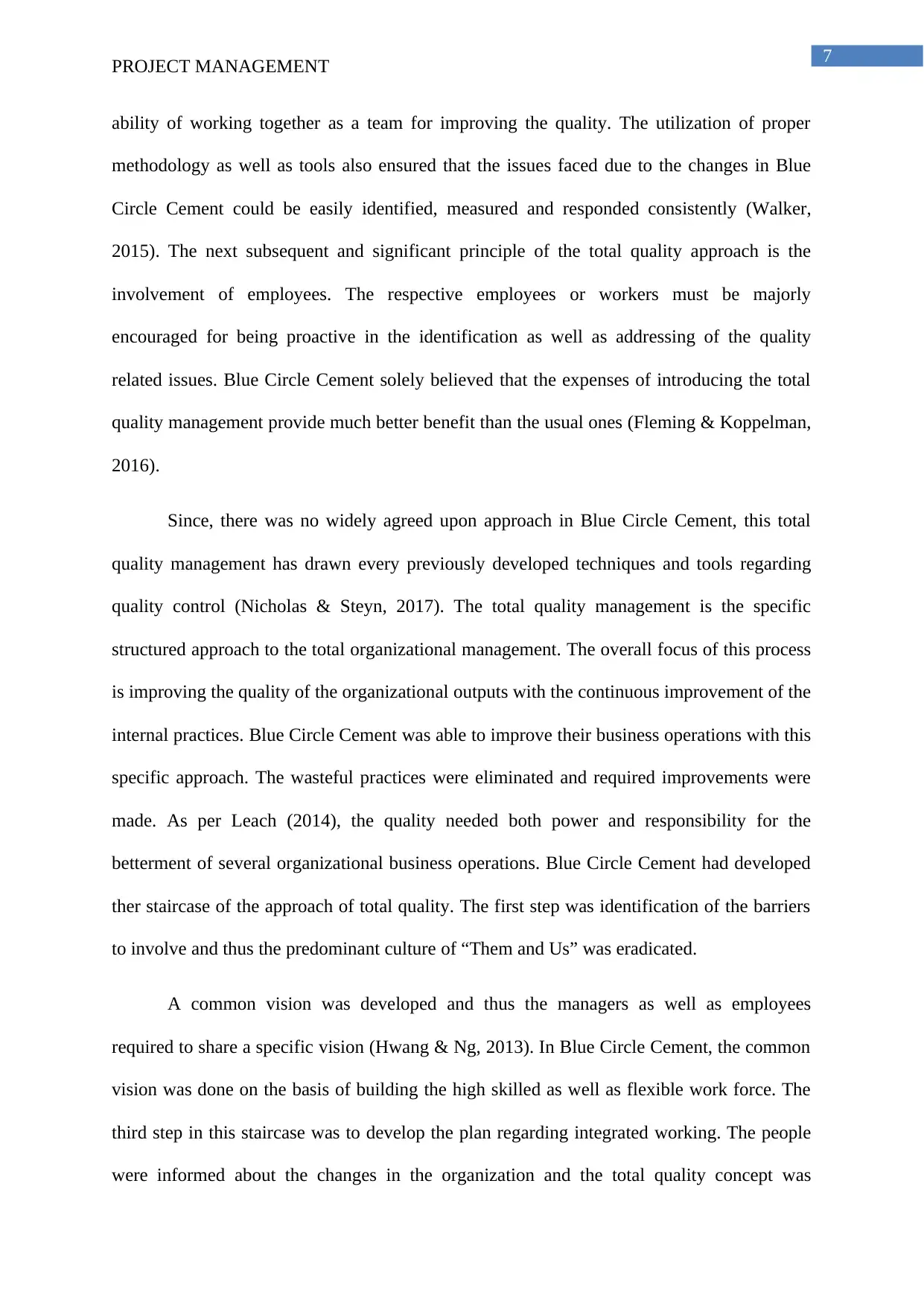
7
PROJECT MANAGEMENT
ability of working together as a team for improving the quality. The utilization of proper
methodology as well as tools also ensured that the issues faced due to the changes in Blue
Circle Cement could be easily identified, measured and responded consistently (Walker,
2015). The next subsequent and significant principle of the total quality approach is the
involvement of employees. The respective employees or workers must be majorly
encouraged for being proactive in the identification as well as addressing of the quality
related issues. Blue Circle Cement solely believed that the expenses of introducing the total
quality management provide much better benefit than the usual ones (Fleming & Koppelman,
2016).
Since, there was no widely agreed upon approach in Blue Circle Cement, this total
quality management has drawn every previously developed techniques and tools regarding
quality control (Nicholas & Steyn, 2017). The total quality management is the specific
structured approach to the total organizational management. The overall focus of this process
is improving the quality of the organizational outputs with the continuous improvement of the
internal practices. Blue Circle Cement was able to improve their business operations with this
specific approach. The wasteful practices were eliminated and required improvements were
made. As per Leach (2014), the quality needed both power and responsibility for the
betterment of several organizational business operations. Blue Circle Cement had developed
ther staircase of the approach of total quality. The first step was identification of the barriers
to involve and thus the predominant culture of “Them and Us” was eradicated.
A common vision was developed and thus the managers as well as employees
required to share a specific vision (Hwang & Ng, 2013). In Blue Circle Cement, the common
vision was done on the basis of building the high skilled as well as flexible work force. The
third step in this staircase was to develop the plan regarding integrated working. The people
were informed about the changes in the organization and the total quality concept was
PROJECT MANAGEMENT
ability of working together as a team for improving the quality. The utilization of proper
methodology as well as tools also ensured that the issues faced due to the changes in Blue
Circle Cement could be easily identified, measured and responded consistently (Walker,
2015). The next subsequent and significant principle of the total quality approach is the
involvement of employees. The respective employees or workers must be majorly
encouraged for being proactive in the identification as well as addressing of the quality
related issues. Blue Circle Cement solely believed that the expenses of introducing the total
quality management provide much better benefit than the usual ones (Fleming & Koppelman,
2016).
Since, there was no widely agreed upon approach in Blue Circle Cement, this total
quality management has drawn every previously developed techniques and tools regarding
quality control (Nicholas & Steyn, 2017). The total quality management is the specific
structured approach to the total organizational management. The overall focus of this process
is improving the quality of the organizational outputs with the continuous improvement of the
internal practices. Blue Circle Cement was able to improve their business operations with this
specific approach. The wasteful practices were eliminated and required improvements were
made. As per Leach (2014), the quality needed both power and responsibility for the
betterment of several organizational business operations. Blue Circle Cement had developed
ther staircase of the approach of total quality. The first step was identification of the barriers
to involve and thus the predominant culture of “Them and Us” was eradicated.
A common vision was developed and thus the managers as well as employees
required to share a specific vision (Hwang & Ng, 2013). In Blue Circle Cement, the common
vision was done on the basis of building the high skilled as well as flexible work force. The
third step in this staircase was to develop the plan regarding integrated working. The people
were informed about the changes in the organization and the total quality concept was
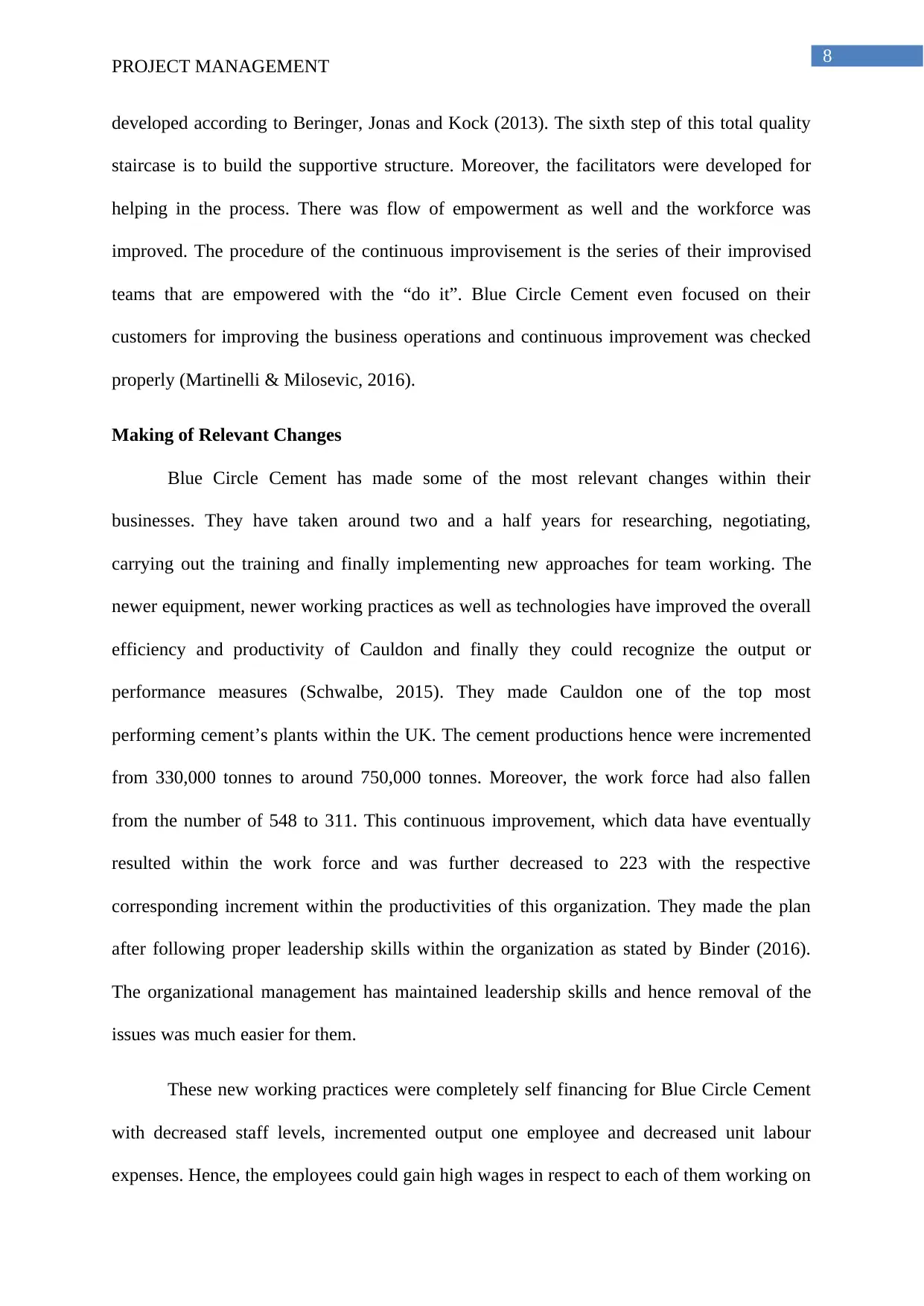
8
PROJECT MANAGEMENT
developed according to Beringer, Jonas and Kock (2013). The sixth step of this total quality
staircase is to build the supportive structure. Moreover, the facilitators were developed for
helping in the process. There was flow of empowerment as well and the workforce was
improved. The procedure of the continuous improvisement is the series of their improvised
teams that are empowered with the “do it”. Blue Circle Cement even focused on their
customers for improving the business operations and continuous improvement was checked
properly (Martinelli & Milosevic, 2016).
Making of Relevant Changes
Blue Circle Cement has made some of the most relevant changes within their
businesses. They have taken around two and a half years for researching, negotiating,
carrying out the training and finally implementing new approaches for team working. The
newer equipment, newer working practices as well as technologies have improved the overall
efficiency and productivity of Cauldon and finally they could recognize the output or
performance measures (Schwalbe, 2015). They made Cauldon one of the top most
performing cement’s plants within the UK. The cement productions hence were incremented
from 330,000 tonnes to around 750,000 tonnes. Moreover, the work force had also fallen
from the number of 548 to 311. This continuous improvement, which data have eventually
resulted within the work force and was further decreased to 223 with the respective
corresponding increment within the productivities of this organization. They made the plan
after following proper leadership skills within the organization as stated by Binder (2016).
The organizational management has maintained leadership skills and hence removal of the
issues was much easier for them.
These new working practices were completely self financing for Blue Circle Cement
with decreased staff levels, incremented output one employee and decreased unit labour
expenses. Hence, the employees could gain high wages in respect to each of them working on
PROJECT MANAGEMENT
developed according to Beringer, Jonas and Kock (2013). The sixth step of this total quality
staircase is to build the supportive structure. Moreover, the facilitators were developed for
helping in the process. There was flow of empowerment as well and the workforce was
improved. The procedure of the continuous improvisement is the series of their improvised
teams that are empowered with the “do it”. Blue Circle Cement even focused on their
customers for improving the business operations and continuous improvement was checked
properly (Martinelli & Milosevic, 2016).
Making of Relevant Changes
Blue Circle Cement has made some of the most relevant changes within their
businesses. They have taken around two and a half years for researching, negotiating,
carrying out the training and finally implementing new approaches for team working. The
newer equipment, newer working practices as well as technologies have improved the overall
efficiency and productivity of Cauldon and finally they could recognize the output or
performance measures (Schwalbe, 2015). They made Cauldon one of the top most
performing cement’s plants within the UK. The cement productions hence were incremented
from 330,000 tonnes to around 750,000 tonnes. Moreover, the work force had also fallen
from the number of 548 to 311. This continuous improvement, which data have eventually
resulted within the work force and was further decreased to 223 with the respective
corresponding increment within the productivities of this organization. They made the plan
after following proper leadership skills within the organization as stated by Binder (2016).
The organizational management has maintained leadership skills and hence removal of the
issues was much easier for them.
These new working practices were completely self financing for Blue Circle Cement
with decreased staff levels, incremented output one employee and decreased unit labour
expenses. Hence, the employees could gain high wages in respect to each of them working on
⊘ This is a preview!⊘
Do you want full access?
Subscribe today to unlock all pages.

Trusted by 1+ million students worldwide
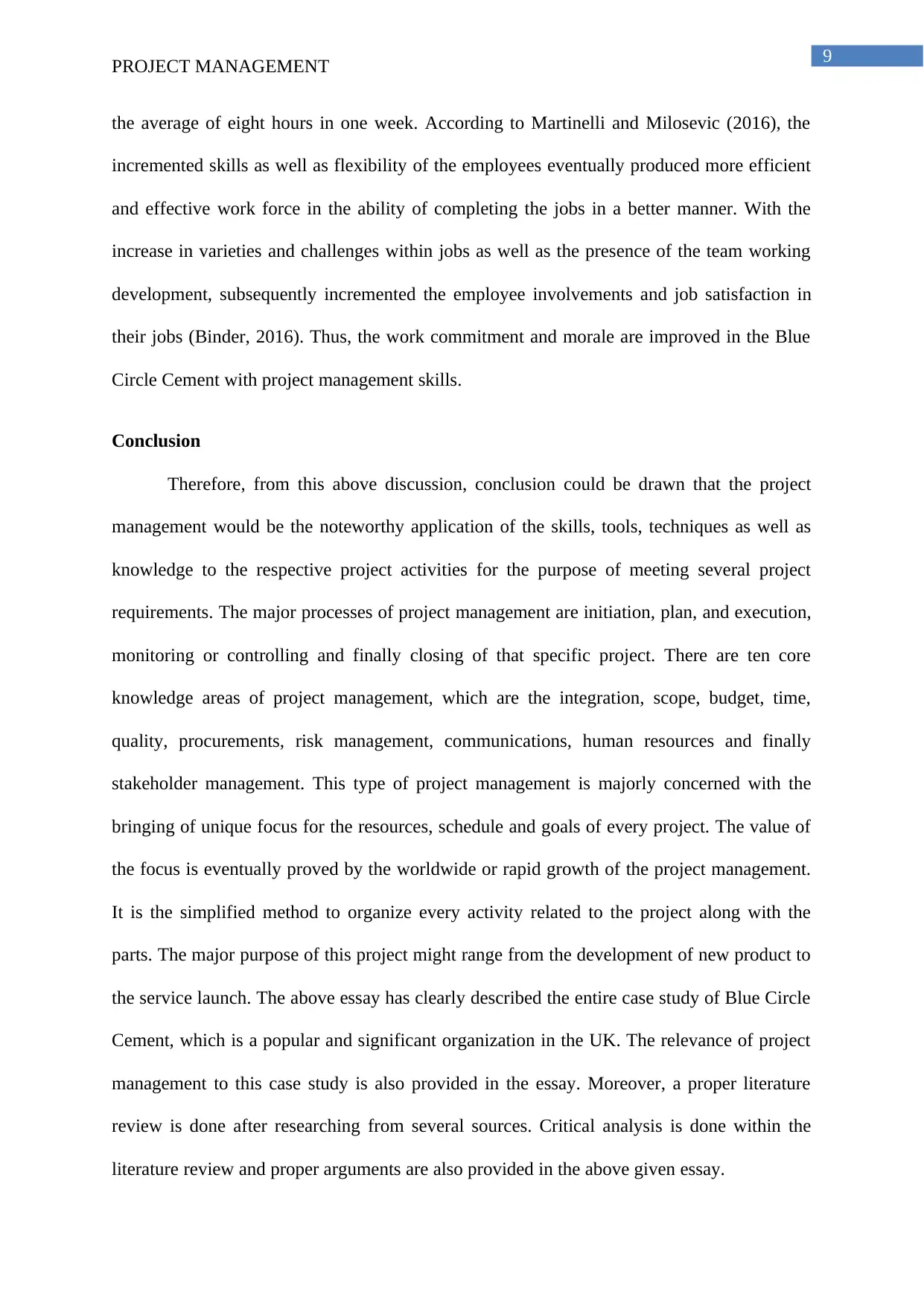
9
PROJECT MANAGEMENT
the average of eight hours in one week. According to Martinelli and Milosevic (2016), the
incremented skills as well as flexibility of the employees eventually produced more efficient
and effective work force in the ability of completing the jobs in a better manner. With the
increase in varieties and challenges within jobs as well as the presence of the team working
development, subsequently incremented the employee involvements and job satisfaction in
their jobs (Binder, 2016). Thus, the work commitment and morale are improved in the Blue
Circle Cement with project management skills.
Conclusion
Therefore, from this above discussion, conclusion could be drawn that the project
management would be the noteworthy application of the skills, tools, techniques as well as
knowledge to the respective project activities for the purpose of meeting several project
requirements. The major processes of project management are initiation, plan, and execution,
monitoring or controlling and finally closing of that specific project. There are ten core
knowledge areas of project management, which are the integration, scope, budget, time,
quality, procurements, risk management, communications, human resources and finally
stakeholder management. This type of project management is majorly concerned with the
bringing of unique focus for the resources, schedule and goals of every project. The value of
the focus is eventually proved by the worldwide or rapid growth of the project management.
It is the simplified method to organize every activity related to the project along with the
parts. The major purpose of this project might range from the development of new product to
the service launch. The above essay has clearly described the entire case study of Blue Circle
Cement, which is a popular and significant organization in the UK. The relevance of project
management to this case study is also provided in the essay. Moreover, a proper literature
review is done after researching from several sources. Critical analysis is done within the
literature review and proper arguments are also provided in the above given essay.
PROJECT MANAGEMENT
the average of eight hours in one week. According to Martinelli and Milosevic (2016), the
incremented skills as well as flexibility of the employees eventually produced more efficient
and effective work force in the ability of completing the jobs in a better manner. With the
increase in varieties and challenges within jobs as well as the presence of the team working
development, subsequently incremented the employee involvements and job satisfaction in
their jobs (Binder, 2016). Thus, the work commitment and morale are improved in the Blue
Circle Cement with project management skills.
Conclusion
Therefore, from this above discussion, conclusion could be drawn that the project
management would be the noteworthy application of the skills, tools, techniques as well as
knowledge to the respective project activities for the purpose of meeting several project
requirements. The major processes of project management are initiation, plan, and execution,
monitoring or controlling and finally closing of that specific project. There are ten core
knowledge areas of project management, which are the integration, scope, budget, time,
quality, procurements, risk management, communications, human resources and finally
stakeholder management. This type of project management is majorly concerned with the
bringing of unique focus for the resources, schedule and goals of every project. The value of
the focus is eventually proved by the worldwide or rapid growth of the project management.
It is the simplified method to organize every activity related to the project along with the
parts. The major purpose of this project might range from the development of new product to
the service launch. The above essay has clearly described the entire case study of Blue Circle
Cement, which is a popular and significant organization in the UK. The relevance of project
management to this case study is also provided in the essay. Moreover, a proper literature
review is done after researching from several sources. Critical analysis is done within the
literature review and proper arguments are also provided in the above given essay.
Paraphrase This Document
Need a fresh take? Get an instant paraphrase of this document with our AI Paraphraser
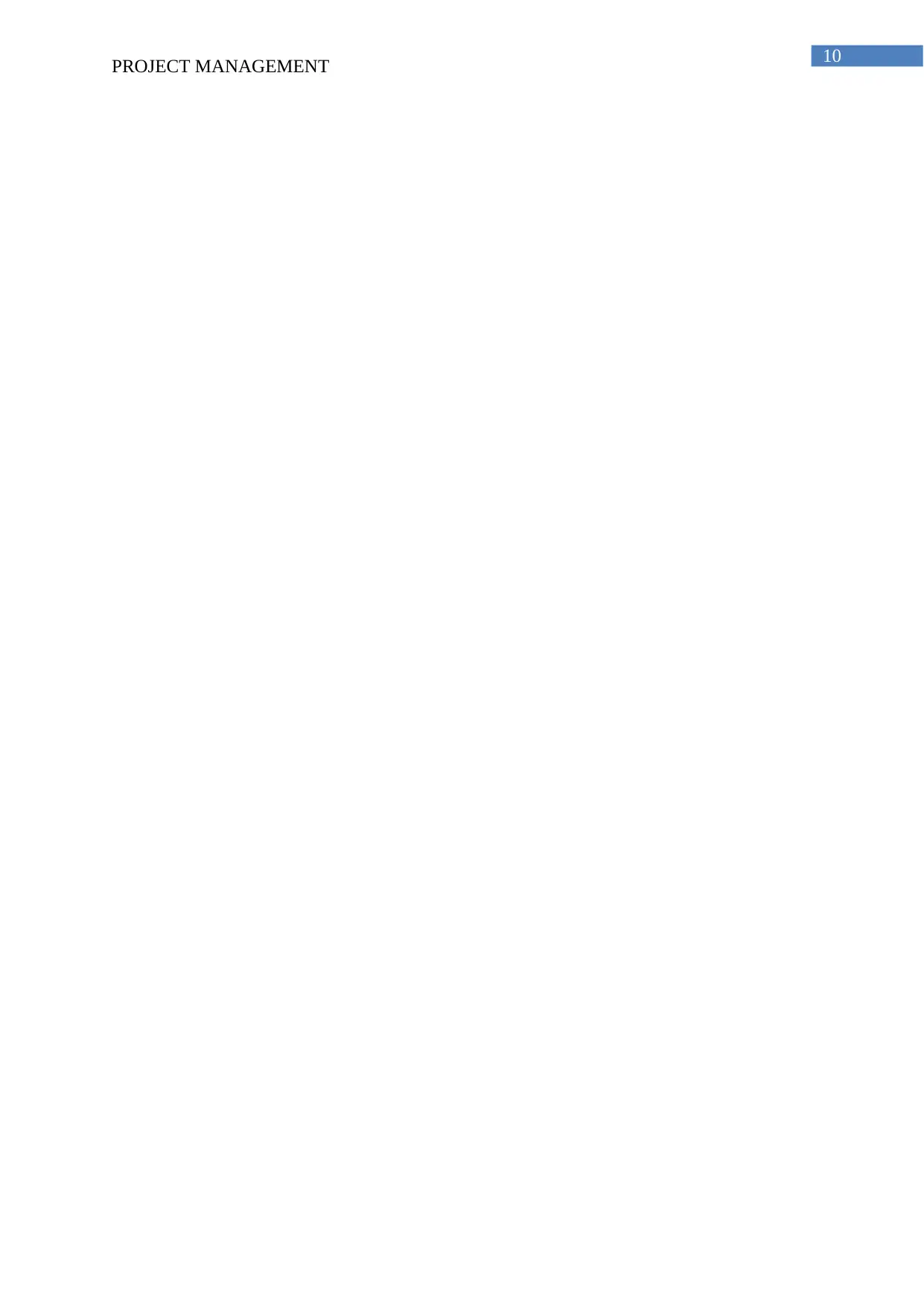
10
PROJECT MANAGEMENT
PROJECT MANAGEMENT
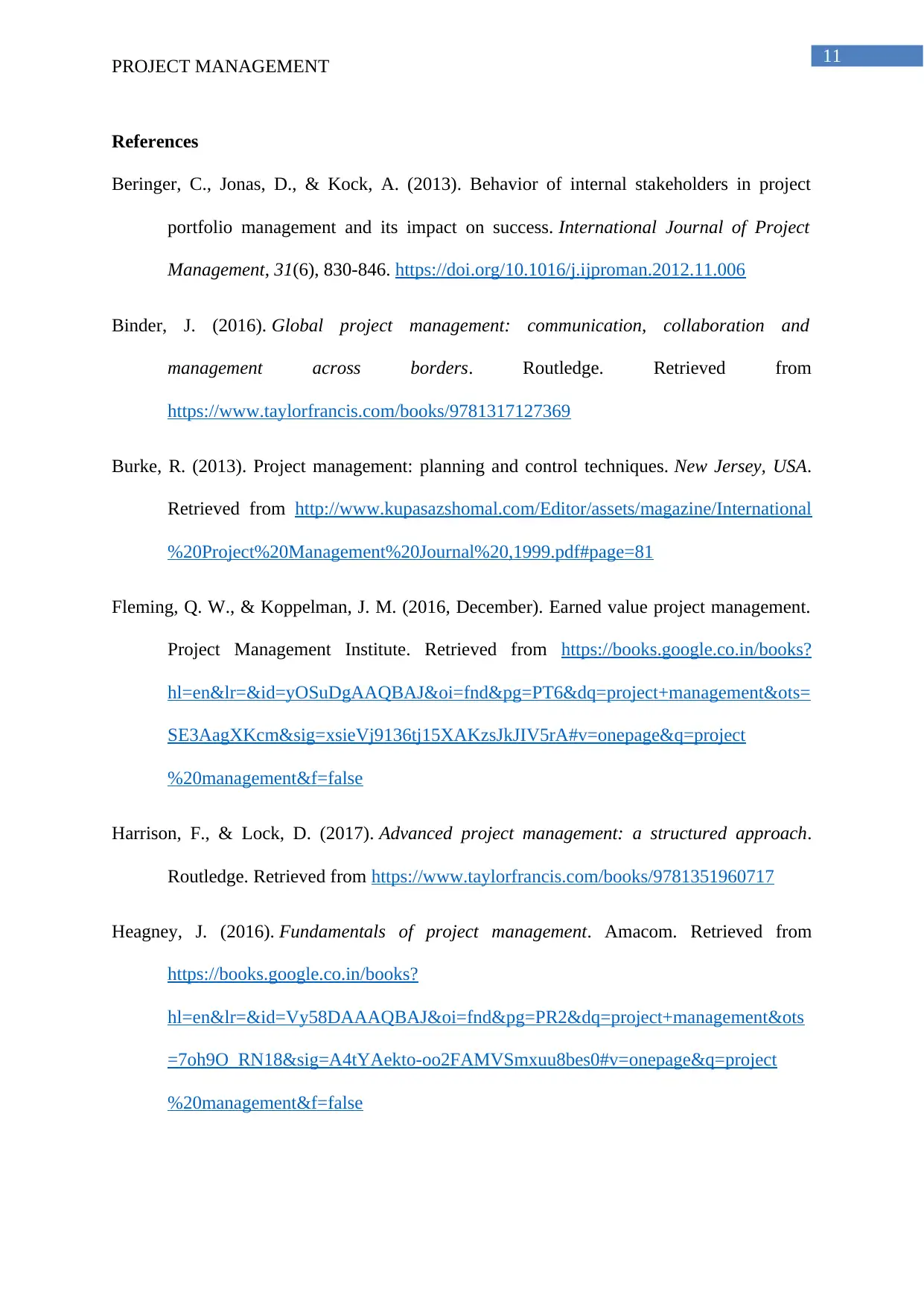
11
PROJECT MANAGEMENT
References
Beringer, C., Jonas, D., & Kock, A. (2013). Behavior of internal stakeholders in project
portfolio management and its impact on success. International Journal of Project
Management, 31(6), 830-846. https://doi.org/10.1016/j.ijproman.2012.11.006
Binder, J. (2016). Global project management: communication, collaboration and
management across borders. Routledge. Retrieved from
https://www.taylorfrancis.com/books/9781317127369
Burke, R. (2013). Project management: planning and control techniques. New Jersey, USA.
Retrieved from http://www.kupasazshomal.com/Editor/assets/magazine/International
%20Project%20Management%20Journal%20,1999.pdf#page=81
Fleming, Q. W., & Koppelman, J. M. (2016, December). Earned value project management.
Project Management Institute. Retrieved from https://books.google.co.in/books?
hl=en&lr=&id=yOSuDgAAQBAJ&oi=fnd&pg=PT6&dq=project+management&ots=
SE3AagXKcm&sig=xsieVj9136tj15XAKzsJkJIV5rA#v=onepage&q=project
%20management&f=false
Harrison, F., & Lock, D. (2017). Advanced project management: a structured approach.
Routledge. Retrieved from https://www.taylorfrancis.com/books/9781351960717
Heagney, J. (2016). Fundamentals of project management. Amacom. Retrieved from
https://books.google.co.in/books?
hl=en&lr=&id=Vy58DAAAQBAJ&oi=fnd&pg=PR2&dq=project+management&ots
=7oh9O_RN18&sig=A4tYAekto-oo2FAMVSmxuu8bes0#v=onepage&q=project
%20management&f=false
PROJECT MANAGEMENT
References
Beringer, C., Jonas, D., & Kock, A. (2013). Behavior of internal stakeholders in project
portfolio management and its impact on success. International Journal of Project
Management, 31(6), 830-846. https://doi.org/10.1016/j.ijproman.2012.11.006
Binder, J. (2016). Global project management: communication, collaboration and
management across borders. Routledge. Retrieved from
https://www.taylorfrancis.com/books/9781317127369
Burke, R. (2013). Project management: planning and control techniques. New Jersey, USA.
Retrieved from http://www.kupasazshomal.com/Editor/assets/magazine/International
%20Project%20Management%20Journal%20,1999.pdf#page=81
Fleming, Q. W., & Koppelman, J. M. (2016, December). Earned value project management.
Project Management Institute. Retrieved from https://books.google.co.in/books?
hl=en&lr=&id=yOSuDgAAQBAJ&oi=fnd&pg=PT6&dq=project+management&ots=
SE3AagXKcm&sig=xsieVj9136tj15XAKzsJkJIV5rA#v=onepage&q=project
%20management&f=false
Harrison, F., & Lock, D. (2017). Advanced project management: a structured approach.
Routledge. Retrieved from https://www.taylorfrancis.com/books/9781351960717
Heagney, J. (2016). Fundamentals of project management. Amacom. Retrieved from
https://books.google.co.in/books?
hl=en&lr=&id=Vy58DAAAQBAJ&oi=fnd&pg=PR2&dq=project+management&ots
=7oh9O_RN18&sig=A4tYAekto-oo2FAMVSmxuu8bes0#v=onepage&q=project
%20management&f=false
⊘ This is a preview!⊘
Do you want full access?
Subscribe today to unlock all pages.

Trusted by 1+ million students worldwide
1 out of 15
Related Documents
Your All-in-One AI-Powered Toolkit for Academic Success.
+13062052269
info@desklib.com
Available 24*7 on WhatsApp / Email
![[object Object]](/_next/static/media/star-bottom.7253800d.svg)
Unlock your academic potential
Copyright © 2020–2025 A2Z Services. All Rights Reserved. Developed and managed by ZUCOL.



